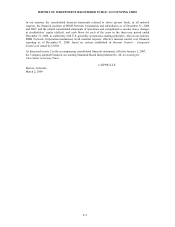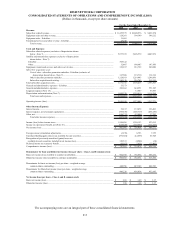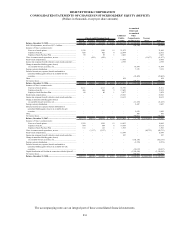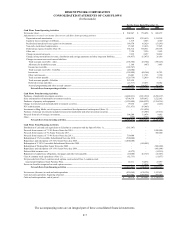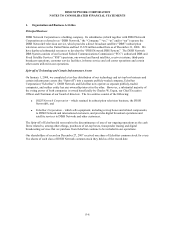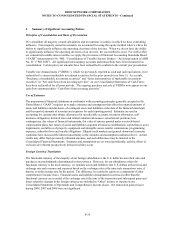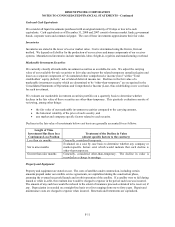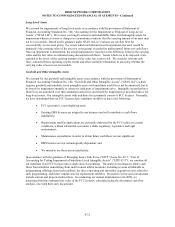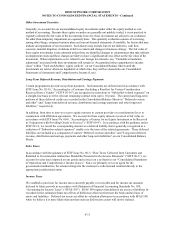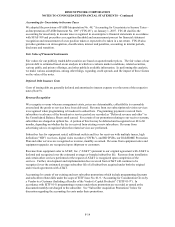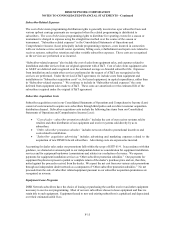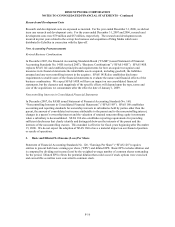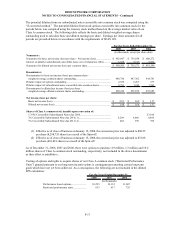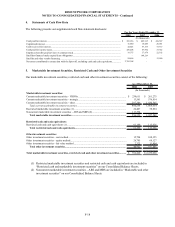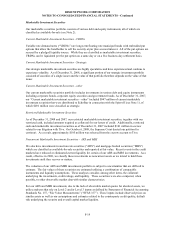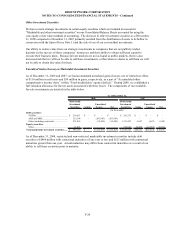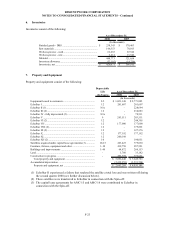Dish Network 2008 Annual Report Download - page 95
Download and view the complete annual report
Please find page 95 of the 2008 Dish Network annual report below. You can navigate through the pages in the report by either clicking on the pages listed below, or by using the keyword search tool below to find specific information within the annual report.DISH NETWORK CORPORATION
NOTES TO CONSOLIDATED FINANCIAL STATEMENTS - Continued
F-13
Other Investment Securities
Generally, we account for our unconsolidated equity investments under either the equity method or cost
method of accounting. Because these equity securities are generally not publicly traded, it is not practical to
regularly estimate the fair value of the investments; however, these investments are subject to an evaluation
for other-than-temporary impairment on a quarterly basis. This quarterly evaluation consists of reviewing,
among other things, company business plans and current financial statements, if available, for factors that may
indicate an impairment of our investment. Such factors may include, but are not limited to, cash flow
concerns, material litigation, violations of debt covenants and changes in business strategy. The fair value of
these equity investments is not estimated unless there are identified changes in circumstances that may indicate
an impairment exists and these changes are likely to have a significant adverse effect on the fair value of the
investment. When impairments occur related to our foreign investments, any “Cumulative translation
adjustment” associated with these investments will remain in “Accumulated other comprehensive income
(loss)” within “Total stockholders’ equity (deficit)” on our Consolidated Balance Sheets until the
investments are sold or otherwise liquidated; at which time, they will be released into our Consolidated
Statements of Operations and Comprehensive Income (Loss).
Long-Term Deferred Revenue, Distribution and Carriage Payments
Certain programmers provide us up-front payments. Such amounts are deferred and in accordance with
EITF Issue No. 02-16, “Accounting by a Customer (Including a Reseller) for Certain Consideration
Received from a Vendor” (“EITF 02-16”) are recognized as reductions to “Subscriber-related expenses” on
a straight-line basis over the relevant remaining contract term (up to 10 years). The current and long-term
portions of these deferred credits are recorded in the Consolidated Balance Sheets in “Deferred revenue
and other” and “Long-term deferred revenue, distribution and carriage payments and other long-term
liabilities,” respectively.
In addition, from time to time we receive equity interests in content providers in consideration for or in
conjunction with affiliation agreements. We account for these equity interests received at fair value in
accordance with EITF Issue No. 00-8, “Accounting by a Grantee for an Equity Instrument to be Received
in Conjunction with Providing Goods or Services” (“EITF 00-8”). In accordance with the guidance under
EITF 02-16, we record the corresponding amount as a deferred liability that is generally recognized as a
reduction of “Subscriber-related expenses” ratably over the term of the related agreements. These deferred
liabilities are included as a component of current “Deferred revenue and other” and “Long-term deferred
revenue, distribution and carriage payments and other long-term liabilities” on our Consolidated Balance
Sheets.
Sales Taxes
In accordance with the guidance of EITF Issue No. 06-3, “How Taxes Collected from Customers and
Remitted to Governmental Authorities Should Be Presented in the Income Statement” (“EITF 06-3”), we
account for sales taxes imposed on our goods and services on a net basis in our “Consolidated Statements
of Operations and Comprehensive Income (Loss).” Since we primarily act as an agent for the
governmental authorities, the amount charged to the customer is collected and remitted directly to the
appropriate jurisdictional entity.
Income Taxes
We establish a provision for income taxes currently payable or receivable and for income tax amounts
deferred to future periods in accordance with Statement of Financial Accounting Standards No. 109,
“Accounting for Income Taxes” (“SFAS 109”). SFAS 109 requires that deferred tax assets or liabilities be
recorded for the estimated future tax effects of differences that exist between the book and tax basis of
assets and liabilities. Deferred tax assets are offset by valuation allowances in accordance with SFAS 109,
when we believe it is more likely than not that such net deferred tax assets will not be realized.


